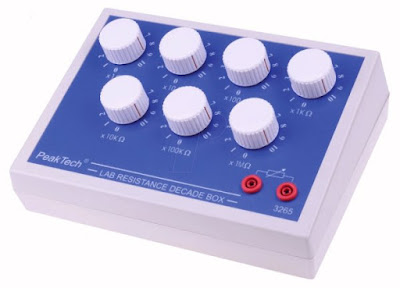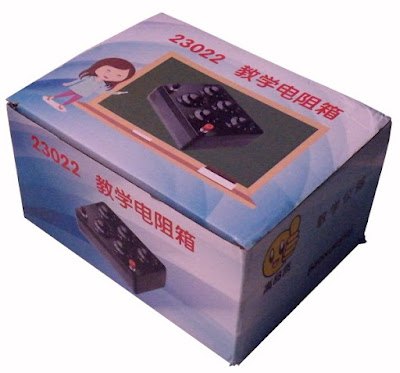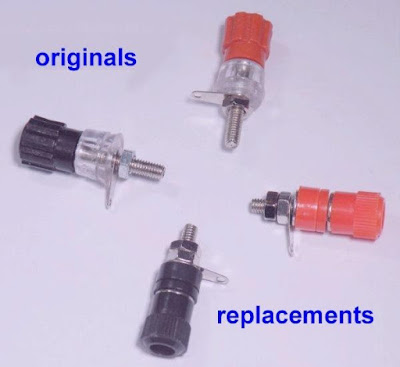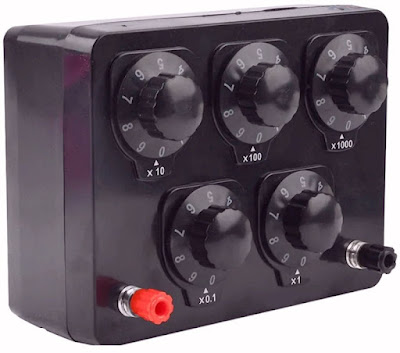Background information: resistor decade boxes
Indispensable when tinkering with circuits yourself
If you design analog circuits yourself, a method to quickly change a resistor in a circuit is very useful. This way you can, for example, adjust an amplifier stage experimentally without having to perform difficult calculations or use a complicated and expensive simulation program. For that quick change of a resistor, a decade box is the most frequently used tool. Such a box consists of a number of calibrated rotary switches that allow you to incrementally increase or decrease a resistance with, say, a resolution of 10 Ω. If your measuring equipment claims that the setting is correct, you can read the value of the resistance from the positions of the rotary switches and replace the box with a fixed resistor.
As useful for bridge measurements
If you ever experiment with bridge circuits, such as wheatstone's, owning a resistor decade box is almost indispensable. With such a box in one of the diagonals of the bridge, you can adjust it neatly and read the value of the appropriate resistance from the box switches.
What is on the market is quite expensive
Unfortunately, the decade boxes on the market are quite expensive for hobby use. For example, in the picture below you can see model 3265 from PeakTech, which allows you to select a resistance between 1 Ω and 11.11111 MΩ with a resolution of 1 Ω and a tolerance of ±5 %. This box costs about € 140.00.
 |
| Model 3265 from PeakTech is an example of a decade box. (© Peaktech) |
After a long search, we found a kit of a decade box at Sparkfun. This KIT-13006 costs only about $ 25.00 and you can use it to set a resistance between 10 Ω and 999.99 kΩ with a resolution of 10 Ω and a tolerance of ±5 %. The disadvantage of this kit is that it does not come in an enclosure and it is not very easy to order from Europe from this American company. However, the kit is also supplied by Digikey which charges € 41.80 for it.
 |
| The kit from Sparkfun. (© Sparkfun) |
The circuit diagram of one resistor decade
In the figure below, the schematic of one decade from such a box is drawn. Each decade consists of the series circuit of nine identical resistors with a value of 1 Ω, 10 Ω, 100 Ω, 1 kΩ, 10 kΩ, 100 kΩ or 1 MΩ. The switch S1 allows you to contact the nodes between the resistors. In the drawn position of the switch, the decade is set to a resistor of 3 kΩ.


The advantage of connecting the resistors in series is that in almost all cases the tolerance of the series connection is smaller than the tolerance of the individual resistors. If the individual resistors have a tolerance of ±5%, it will rarely if ever happen that all the resistors in the series circuit have an identical tolerance. In practice, one will have a positive deviation of 2 %, the next will have a negative deviation of 3 %, etc. Some of the negative deviations are compensated by the positive deviations and the series connection of the resistors is more accurate than the individual resistors.
 |
| The schematic of one resistor decade. (© 2023 Jos Verstraten) |
The Chinese alternative: model 23022
Introduction to model 23022
By several Chinese suppliers, a very cheap resistor decade box is offered for prices starting at just over € 10.00. And that often with free delivery! We ordered two specimens from the 'Tools Drop-Ship Store' on AliExpress. This box, whose manufacturer is not made public and known only by the code '23022', comes in a sturdy black case measuring 160 mm x 120 mm x 60 mm and weighs 302 g. The five large dials allow you to adjust the resistance between (in theory) 0.1 Ω and 9999.9 Ω.
There are no 4 mm banana plug sockets, but screw connectors under which you have to clip a wire. Fortunately, these can be replaced with 4 mm banana plug sockets without any problems, so you can connect the box via standard test leads with 4 mm banana plugs.
Thanks to the large knobs, the five rotary switches are smooth to operate and clearly click into their positions.
Not a negative word to say about the appearance of the device!
 |
| The appearance of the resistor decade box model 23022. (© AliExpress) |
Scope of delivery
The device comes in a cardboard box and with a manual in Chinese.
 |
| The packaging of model 23022. (© 2023 Jos Verstraten) |
The specifications according to the supplier
- Resistance range: 0 Ω ~ 9999.9 Ω
- Resolution: 0.1 Ω
- Tolerance: ±1.0 %
- Residual resistance when set to zero: < 0.03502 Ω
- Power: 0.5 W
- Insulation between switches and housing: > 50 MΩ
These are specifications that may be called professional, but until we are proven wrong, we take them with a large grain of salt.
The internal of model 23022
The front panel is attached to the housing with four long screws. These can be removed through the back. One of the reasons for the low price becomes immediately clear. One has not used expensive standard rotary switches, but opted for a system where the switch contacts are integrated into the PCB design. Over the circular copper track's slide metal contact bridges that rotate around when you turn the device's knobs. This seems at first a very unreliable design, but remember that virtually all multimeters that have a large rotary switch operate in an identical manner.
Clearly, the switches have two 'poles' and we are not dealing with a 1x10-position switch but a ten-position switch whose five positions contact one pole and five other positions contact the second pole.
There is little logic to be found in the way the tracks are arranged on the PCB and even less in the various widths of these tracks. In any case, the design of the PCB does not leave a professional impression.
 |
| The internal of model 23022. (© 2023 Jos Verstraten) |
The click positions of the switches
Remains to be investigated how the switches click into their positions so clearly. In the underside of the round discs around the knobs of the switches, there is a round groove in which ten pits are drilled. When turning the knob, a small metal bullet falls into these pits. This bullet has nowhere else to go, as it is trapped between an identical pit in the front panel and the groove and pits on the underside of the knob.
This construction also ensures that the button of the switch is pressed upwards, an action that results in the sliding contacts being pushed against the PCB in the device.
A cheap and clever solution! Nevertheless, we would have preferred to have at least two of those little bullets. That would definitely improve the long-term reliability of this construction.
Details of one switch
In the photo below you can see a detail picture of one of the five switches. You can clearly see on the copper track's traces of the tips of the sliding contacts. What is further noticeable is the presence of only five tiny SMD resistors soldered between the PCB traces. Judging by the dimensions, those resistors are of type 3216 with dimensions of 3.2 mm by 2.5 mm and a power of 1/4 W. So the specified power of 0.5 W is not correct! Four of those resistors have a value of 1R00, the fifth of 4R99 (or of course ten multiples of that). The value 4.99 occurs only in the E96 and E192 series. So we assume that resistors with a tolerance of ±1.0% are indeed used.
 |
| Detail of one of the switches. (© 2023 Jos Verstraten) |
The schematic of one decade
In the figure below we have drawn the schematic of one decade. Clever how the designers even managed to economize on the extremely cheap SMD resistor! Five pieces instead of nine!
 |
| Schematic of one of the decade switches. (© 2023 Jos Verstraten) |
Replacing the connectors
As already written, model 23022 comes with two screw connectors under which you have to clip a wire. We recommend that you replace these with normal 4 mm banana plug sockets. This is very easy to do. In the picture below you can see the existing screw connectors above and the replacement 4 mm banana plug sockets below. The screw threads are identical, the bolts are identical and even the solder tabs are identical. Just unscrew, replace and screw back on. Done!
 |
Replacing the connectors. (© 2023 Jos Verstraten) |
Accuracy measured
Of course, the main question is whether such a cheap decade box provides a resistance setting that can be trusted. We measured the resistance of both boxes we bought using the four-wire method with our reference meter 8842A from Fluke. The results are summarized in the table below.

As might be expected, the zero resistance of 0.03502 Ω given in the specifications is nothing more than a manufacturer's wet dream. Such a low value will hardly be achievable even with the most expensive boxes and thus certainly not with such a simplistic construction as a contact bridge sliding over copper, not even gold-plated, tracks on a PCB. The large percentage deviation when set to 1.0000 Ω can be fully explained by the high zero resistance of 300 mΩ. The higher you set the resistance, the smaller the influence of that zero resistance obviously becomes. The measured average percentage deviation at settings over 100 Ω is definitely excellent.

As might be expected, the zero resistance of 0.03502 Ω given in the specifications is nothing more than a manufacturer's wet dream. Such a low value will hardly be achievable even with the most expensive boxes and thus certainly not with such a simplistic construction as a contact bridge sliding over copper, not even gold-plated, tracks on a PCB. The large percentage deviation when set to 1.0000 Ω can be fully explained by the high zero resistance of 300 mΩ. The higher you set the resistance, the smaller the influence of that zero resistance obviously becomes. The measured average percentage deviation at settings over 100 Ω is definitely excellent.
 |
Accuracy of two boxes measured. (© 2023 Jos Verstraten) |
Our conclusion about this resistor decade box
Sometimes we have a hard time understanding the decisions of designers of electronics products. This is certainly true of this resistor decade box.
First of all, we don't understand why someone would list a completely implausible value like zero resistance < 0.03502 Ω with the specs, when anyone who knows anything about electronics realizes that this is absolute nonsense.
Why the designers chose a lowest decade of 0.1 Ω to 0.9 Ω is also a mystery to us. After all, this range is completely lost in the zero resistance of the switches. The range from 1 Ω to 9 Ω is also so degraded by the high zero resistance that its practical usefulness is negligible. Much more sensible would have been for the designers of this product to increase the range by a factor of one hundred. A resolution of 10 Ω on resistor setting is more than good enough in almost all cases. The advantage is that the highest range is not 9.9999 kΩ but a much more usable 999.99 kΩ.
Modifying the decade box
A more convenient range
The range from 0.1000 Ω to 9.9999 kΩ is rather impractical. Hence, we converted our two specimens by replacing the mini-SMD resistors with larger ones and also multiplying all values by a hundred. This creates a decade box with a range of 10.000 Ω to 999.99 kΩ, which is obviously much more practical. The result will be a useful addition to your hobby lab and at a bargain price!
The resistors
We ordered a set of Yageo metal-film resistors from the German company Reichelt Elektronik with a tolerance of ±1.0% and a power of 0.6 W. These cost just € 0.11 each, you need 25 per decade box which brings the total extra investment to € 2.75!
 |
| The order codes of the resistors. (© 2023 Jos Verstraten) |
Removing SMD resistors, soldering axial resistors
Of course, you first need to unsolder the SMD resistors and replace them with their axial counterparts. You can see the work involved on one decade in the picture below.
 |
| The SMD resistors have been replaced. (© 2023 Jos Verstraten) |
The new measurement results
After replacing all the resistors, we naturally carried out another test, the results of which are summarised in the table below. For some reason, the zero resistances of both boxes increased substantially from about 0.3 Ω to about 0.8 Ω. This obviously explains the large error when set to 10.000 Ω. For higher resistance values, the box satisfies perfectly with percentage deviations much lower than the ±1 % of the individual resistors.
 |
| The measurement results of the modified boxes. (© 2023 Jos Verstraten) |


